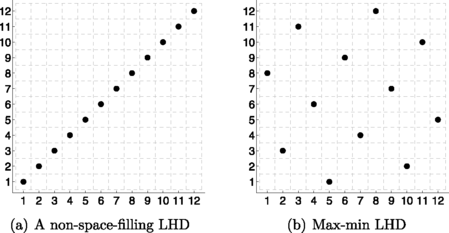
- LATIN HYPERCUBE SAMPLING GIVEN BOUNDS MATLAB SERIES AT A
- LATIN HYPERCUBE SAMPLING GIVEN BOUNDS MATLAB CODE USING MATLAB

Loh (1996) extends this result to the multivariate case where g: Rd 7Rm. And shows that, asymptotically, the sample variance from Latin Hypercube sampling is just equal to the variance of the residual term and is no worse than the variance from Monte Carlo sampling. I'd like to make a 1,000 equally distributed samples from each distribution by the method of latin hypercube sampling.
Latin Hypercube Sampling Given Bounds Matlab Code Using Matlab
Latin Hypercube Sampling, Hamilton or Sobol sequences) is selected and IQs are determined for three types of sampling points, using the numerical model that best represents the analysed problem. A suitable sampling method (e.g. Since earthquakes remain the greatest natural disaster for modern society, causing loss of life and millions of damages to the urban environment, the efforts of earth scientists and engineers lie in providing the tools for quick and adequate assessment of potential damage.STKSAMPLINGNESTEDLHS builds a Nested Latin Hypercube Sampling (NLHS) CALL: X stksamplingnestedlhs (N, DIM) builds a NLHS, with length(N) levels.Initially, the sampling plane to be considered for the generation of IQs, is dened. This chapter presents the implementation of seismological and earthquake engineering principles and the development of innovative computer code using Matlab platform.
Nowadays, knowledge about the level of the anticipated shaking near cities or villages is directly linked with past observations. The seismic parameters involved in this estimation are the magnitude of the earthquake, the distance between the epicenter and the site in question, the description of the site’s geological formations and additional characteristics of the earthquake’s rupture style. Stratied LH sampling is a form of im-portance sampling The foundation of seismic hazard analysis is based on the accurate scientific estimation of anticipated ground motion at a site following the occurrence of a strong earthquake. The marginal proba-bility distribution for each parameter is stratied into equal probability bins, from which a Latin hypercube is constructed.
Latin Hypercube Sampling Given Bounds Matlab Series At A
Matlab through resample1function provides the necessary tool to produce an equally sampled time series at a given sampling interval. No matter the progress of modern technology, scientists in earthquake prone countries cannot simply ignore the older analog acceleration time series, which in many cases can be irreplaceable. The goal of this chapter is two-fold firstly to provide an insight of the necessary Digital Signal Processing steps, easily performed through Matlab, leading to the derivation of earthquake engineering parameters and secondly testing traditional regression analysis and optimization in order to develop empirical equations modeling the aforementioned parameters.According to modern data acquisition practice once an earthquake, exceeding a specific threshold occurs, ground motion time-series recorded by digital seismometers or accelerometers, usually at a sampling frequency equal to 200 samples-per-second, are transmitted to the data analysis center. Seismological data collection and analysis is a demanding time-consuming task, related with Digital Signal Processing and Data Archiving.

After the determination of the unknown function, through cubic spline approximation, it is straightforward to calculate the area of interest under response spectrum by evaluating the cubic spline function in the interval of interest. The above can be implemented through the combined use of difffunction for calculating differences and approximate derivatives, at points (SV (ω,ζ), T) between 0.1 s and 2.5 s ( Figure 6), the cumulative sum function cumsumand the cubic spline approximation function csapi. Matlab makes possible the approximation of this unknown mathematical function, corresponding to the graph, using the boundary integral method ( Liggett & Salmon, 1981) through a spline curve using chord-length parametrization and cubic spline interpolation. The critical issue behind the derivation of SI, and other parameters, is related with the common problem of calculation the area under the graph of an unknown function.
In the next section the development of an empirical model, aiming to predict the anticipated peak ground acceleration (PGA) during a strong earthquake, is briefly described.L o g 1 0 ( P G A ) = a + b M + c M 2 + ( d + e M ) l o g 1 0 R 2 + ( H - h ) 2 + e + f E3In Equation (2) the seismic magnitude M, distance R (km) and depth H (km) are considered to be the independent variables of the model ( Equation 2). Pga=.At this point the calculation of engineering parameters, such as PGA, corresponds to the observations (OBS) of the natural system, reaches to an end. Output Data Structure (OPD) can be achieved through Command Prompt lines e.g OPD. Assigning fields in a structure array called e.g. PGA, can be assigned as fields of a structure array. To overcome this problem the desirable parameters e.g.
The contribution of optimization to geophysics has been interestingly growing the last decades due to its efficiently in modelling complex natural systems by determining the best solution from a set of alternative solutions ( Goldberg, 1989). The traditional method to determine the coefficients of Equation (2) corresponds to regression analysis whereas modern techniques of mathematical optimization are developed over the last decades. From this point on the scientific effort focuses in solving equation (2), corresponding to the determination of the coefficients.
In the following section the advantages of optimization versus regression would be analysed and the best solver for optimization process would be selected through a test involving a number of important deterministic and stochastic algorithms.In theory, traditional regression analysis -discussed in previous paragraph- is expected to provide one possible solution for any given equation.


 0 kommentar(er)
0 kommentar(er)
